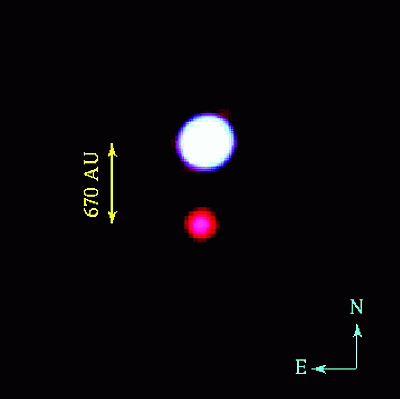 | |||
|
| Home > Public Information > Scientific Highlights > 2008 > A Wide Companion Near the Deuterium Mass Limit |
A Wide Companion Near the Deuterium Mass LimitWHT+ISIS, WHT+AUX
A team of Spanish astronomers has identified a stellar companion near the deuterium-burning mass limit located at a very wide distance,
or 670 astronomical units, from the brown dwarf UScoCTIO 108 in the very young Upper Scorpius association.
Although other substellar pairs with similar mass ratio are known, the system UScoCTIO 108A and B is the widest identified so far and possibly
has a lower gravitational bound energy than any other known low-mass binary.
It seems very difficult to explain the in situ formation of this object in a disk by core accretion or disk instability. Given the typical size and density profile of stellar disks, there does not seem to be enough mass at such a wide separation to form a companion of this mass, unless it has originated at a lower distance and migrated to its present location. Because of the low binding energy, it is unlikely that the system has been ejected from a higher-mass unstable multiple system. A more plausible scenario is that the system was originated from the disruption of a more massive core in a way similar to how other binary stars are supposed to be formed. If the formation of these wide and very low mass systems in the denser central part of clusters is relatively frequent, this could explain the existence of isolated planetary-mass objects as planetary-mass companions that became unbound from their primaries. Optical and near-infrared photometry and spectroscopy using ISIS and Aux Camera on the William Herschel Telescope, among other instruments, confirmed the cool nature of both UScoCTIO 108A and B, with spectral types of M7 and M9.5, and that they are bona fide members of the Upper Scorpius association, showing low gravity and features of youth. Their inferred masses are 60±20 and 14+2-8 Jupiter masses respectively.
More information:
|
| Top | Back |
|


